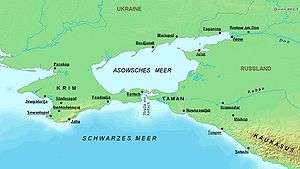Taman Peninsula
The Taman Peninsula (Russian: Тама́нский полуо́стров, Tamanskiy poluostrov) is a peninsula in the present-day Krasnodar Krai of Russia, which borders the Sea of Azov to the North, the Strait of Kerch to the West and the Black Sea to the South.

History
The area has evolved over the past two millennia from a chain of islands into today's peninsula. In ancient times the Pontic Greek colonies of Hermonassa and Phanagoria stood on the peninsula, as did the later city of Tmutarakan.[1]
The Maeotae and Sindi settled in the area from ancient times. In the classical period it became part of the Bosporan kingdom; its inhabitants included Sarmatians, Greeks, Anatolian settlers from Pontus, and Jews. In the 4th century CE the area fell to the Huns; it was later the capital of Great Bulgaria and fell to the Khazars in the mid-7th century. Following the breakup of the Khazar Khaganate in c. 969, the peninsula formed part of a Khazar Jewish successor state under a ruler named David. By the late 980s it came largely into the possession of the Kievan Rus and of the Russian Principality of Tmutarakan before falling to the Kipchaks c. 1100. The Mongols seized the area in 1239 and it became a possession of Genoa, along with Gazaria in Crimea, in 1419.
For most of the 15th century the Guizolfi (Ghisolfi) family, founded by the Genoese Jew Simeone de Guizolfi, ruled the peninsula on behalf of Gazaria. The rulership of the region by Jewish consuls, commissioners or princes has sparked much debate over the extent to which Khazar Judaism survived in southern Russia during this period. The Khanate of Crimea seized the Taman Peninsula in 1483. Either It fell to the Ottoman Empire in 1783. In 1791, during the Russo-Turkish War (1787–92), it passed into the control of the Russian Empire. Russia ceded it back to the Ottomans in 1792. It finally passed to Russia in 1828.[2] It was a Turkish Sanjak under the Eyalet of Kaffa and passed to Russia in 1784.
For much of the succeeding century, the area was sparsely populated. The largest settlement was the Cossack town (later a stanitsa) of Taman, succeeded by the port town of Temryuk in modern times. Mikhail Lermontov describes the town of Taman (disparagingly) in his novel, A Hero of Our Time. The peninsula contains small mud volcanoes and deposits of natural gas and petroleum.
The German Wehrmacht and the Romanian Army occupied the Taman Peninsula in 1942; the Soviet Red Army recovered it in 1943.[3] The story of the motion picture Cross of Iron revolves around conflicts that arise within the leadership of a Wehrmacht regiment during the German retreat from the Kuban bridgehead.
In 2018, archaeologists discovered the remains of ancient Greek musical instruments, a harp and a lyre. The instruments discovered while examining an ancient necropolis located near the Volna settlement. Archaeologists say that a Greek polis existed there from the second quarter of the 6th century BC to the 4th century AD, which belonged to the Bosporan Kingdom.[4]
References
- "Greek colonization in the northern Black Sea area". German Archaeological Institute. Retrieved 4 April 2010.
- Tsutsiev, Atlas of the Ethno-Political History of the Caucasus, 2004
- Robert Forczyk, The Caucasus 1942–43: Kleist’s race for oil
- Russian archaeologists discover ancient Greek musical instruments near Crimea